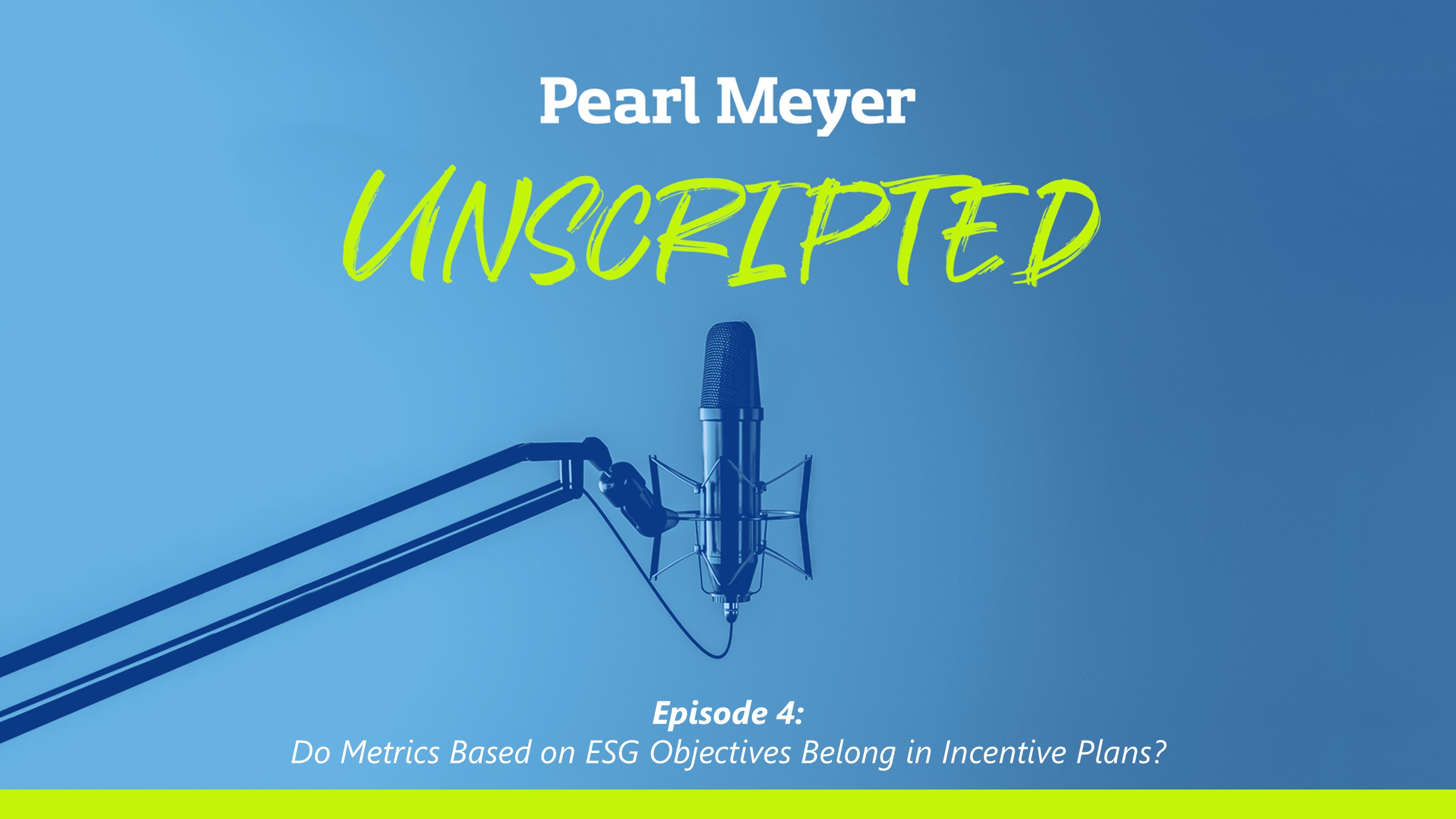
Podcast | Oct 2025 | The Pearl Meyer Unscripted Podcast
Do Metrics Based on ESG Objectives Belong in Incentive Plans?
S2 Ep4: Most companies track ESG metrics—but should they factor into incentive plans?
Transcript
Jake: Nearly every company tracks some degree of ESG measure, but do such metrics belong in incentive plans? Welcome to another Unscripted Episode. I'm Jake George, CMO at Pearl Meyer, and my colleagues Mark Rosen and Aalap Shah are discussing hot topics likely to be on the minds of Comp Committee members during their Fall meetings. Today, they're joined by our colleague Jan Koors to take on a topic that is often seen as especially hot when it comes to differing views on the political spectrum, ESG metrics. Let's listen in as they discuss whether these and other non-financial metrics are appropriate to include in incentive plans.
Mark: Hey, Aalap. Good seeing you again.
Aalap: Hey Mark!
Mark: I got another topic that you and I have had some pretty good internal debates over. And as we get ready for going out and visiting boards again this fall, probably a good idea to visit on it again. It's the whole concept of ESG. Does it belong in incentive plans? And how should committees think about it?
Aalap: Mark, I think you're absolutely right. I mean, there continues to be a lot of information in newspapers as well as in board meetings that I've had over the summer, just really talking about ESG. So, in my view, continues to be a hot topic. And so I've invited Jan Koors into our conversation to shed some light and give us a bit of an overview of what she's hearing these days and what should we be thinking about as we go into the compensation cycle.
Mark: Hey, Jan.
Jan: Hey guys, how you doing?
Mark: Good.
Jan: So what's our topic for the day?
Aalap: Yeah, as you know, Mark and I have had some healthy debates past few years on ESG. And we were just wondering if you can give us your thoughts on what's happening now, what are you hearing, what should we be thinking about?
Jan: Sure. I mean as you know the old line ESG metrics, customer service, safety, employee satisfaction, have been around for a long time. And those have always been part of the way companies measure performance for their business and the way they incent plan participants in certain industries for really long time.
Then we saw probably, you go back five or six years, following the 'Me Too' movement, following Black Lives Matter, following a lot of the climate discussions, you saw what I would refer to as kind of "new age ESG metrics" start to come into play. DEI metrics, carbon footprint metrics, and those we saw a really rapid adoption among public companies in their incentive plans starting in say, 2020 and up through, say, 2023. We saw significant year-over-year increases in prevalence every year. A lot of those measures were pretty fuzzy, they weren't hard and fast metrics necessarily in the incentive plans. They were more alike, you know, we promised to do better in the future or carbon footprint metrics that were, you know, 20 years out, which is long past the shelf life of any of the current sitting executives. So it's some issues with how those measures were implemented, but a lot of companies got on that bandwagon. We are now seeing certainly with DEI, a little less so with the climate metrics, but certainly on the DEI side for all of those companies who felt social and political pressure to do DEI, many companies are now feeling social and political pressure to undo DEI.
I think this is where the board and the management team has to sit back and say, okay, we need to be looking more inward to our own culture, to our own company, to what creates value for us, to what our cultural beliefs are, and really rationalize those metrics around, if we've got it, do we keep it? Or if we've got it, did we get on it because it was a bandwagon thing, and it really isn't part of who we are, and we're going to bite the bullet and take it out? And there's a lot of opinions that are pretty strongly held on both sides of the political divide.
That said, I would say we all know that kind of heat doesn't do us any favors in the boardroom. So I think part of our challenge as we talk to companies about this and part of our clients challenge when they're sitting in their comp committee meetings is, how do we lower the temperature around these discussions?
Aalap: And so when you think about lowering that temperature, I mean obviously it's something that we are dealing with on a constant basis is impact on incentive plants. What is your view on ESG and its appropriateness in incentive plants?
Jan: When we think about incentive plans and what we want incentive plans to do, the goal of an incentive plan should be to impact actions and behaviors of our employee population. Financial measures are good, but financial measures are backwards looking. So what we want to do is think about are there leading indicators that are non-financial that make sense and will drive future financial performance? So if you think about ESG type measures, whether it's the non-controversial ESG measures like safety, like customer service, or the ones that are a little more politically fraught right now, like diversity or carbon footprints, it should be in boardrooms the same discussion. By tracking this measure, will it improve the company's performance, make us do more good things, make us do less bad things, make us do different things that will get us a better outcome? Over and above, will it actually drive the performance that we're after? Then you can have a subsequent discussion about, and if that's the case, do we believe it belongs in the incentive plan? Because those two things don't necessarily automatically go together.
Mark: Don't you communicate what's important through incentive plans? And some of these things are extremely important to the organization. And we're not necessarily viewing them as a leading or trailing indicator but rather putting a stake in the ground and saying, this is very important.
Jan: Yeah, more of a cultural landmark, if you will. And here what I would say is if I think about it on the incentive plan side, there are some things that you just want to embed in the culture. And there are other ways to make those important. I mean, yes, an incentive plan is absolutely a tool communicating an organization's priorities and objectives. On the other hand, so is how you promote people. So is succession planning. So are raises, so are career development opportunity. There are lots of tools that that a management team and a board has to deliver a message about what is and isn't important to the organization beyond just the 5% of a 15% annual bonus opportunity.
Mark: Clearly some of these are the values that organizations hold. For example, some people would view it as trying to promote unrepresented minorities, but others would say, 'hey, we've got to reflect our customers, but also we've got talent in our organization and we need to find a way to make sure that we are promoting all the talent that we have.' How do you think about that as it relates to an incentive plan from a risk perspective of what it might look like externally versus sending appropriate messages internally? What's your advice to the board?
Jan: I think my advice to the board on that front is nobody likes the idea of quotas. And DEI was never intended to be a quota thing. This is really about making sure that you don't have unintended biases against anybody. But here I think there is an evolution, or at least I think I've seen an evolution. I think many companies first got on the ESG bandwagon from a defensive position, kind of litigation mitigation, right? So, I'm going to take a defensive posture around those incentive metrics, both how I measure them, how I weight them, how I put them in the incentive plan as a way to limit risk or to manage risk. But then as you start to move, I think there is an evolution in thinking about the risk side to say, 'do we evolve to looking at the opportunities?' And it becomes an opportunity cost not to do it. Because doing these things will generate positive results versus simply avoiding negative results. It's kind of two sides of the same coin, but I think the real value, when you start talking about real upside value creation, is on the 'will doing it generate positive results?'
Aalap: And so when you think about that and how we should select the appropriate metrics that might go into an incentive plan versus ones that are part of just our cultural norm, I think it's something that you said earlier about value creation and what metrics maybe lead to value creation, I think, ends up being a very important point. So how do you go assessing that from a metric perspective?
Jan: Well, I think this comes back to the discussion around what really drives the business and how do we make the business case for it? And it should be about a discussion of how does this metric or how do these issues play into our culture and the kinds of behaviors and actions that we want our employees to exhibit. And so from that perspective, when you think about driving behavior and actions. That's a big part of what we think about when we choose what metrics we put into an incentive plan and what metrics we don't.
I think the other thing to think about when you're doing incentives planning is think about what we love about financial metrics. They're measurable, they're consistent, they're repeatable, and so part of what we want for the non-financial metrics is that same kind of consistency. Is it something where we can set a baseline? Is it something that we can easily measure and track? Is it something where the results and the measurement process is repeatable and consistent so that when we say to somebody, 'yes, we improved or no, we fell short,' that that's a legitimate answer that the participants are all going to look at and say, 'yeah, we buy into it.' I mean, part of the issue with some of the non-financial measures is the measurement themselves gets a little fuzzy, and that makes for a bad incentive measure.
Aalap: Jan, in wondering whether it should be part of the incentive program. What level of materiality should any of these metrics have? So historically, we have seen when companies have included ESG or even DEI in their incentive programs, it's primarily in the bonus program. And it generally is about 10 to 15% of the metrics associated in the bonus program. When you think about that in total compensation, that may actually total less than 7% or 8% of total compensation. So, how important is it to really have it in the incentive program?
Jan: So, you're right. There's a few things here that are worth talking about. One is, it does end up being a really small percentage of somebody's overall pay, even at the highest levels of bonus plan, it's still going to be a relatively small percentage of somebody's total pay.
And yet, there's no appetite to increase the percentage of these non-financial metrics because where are you going to take it from? In order to give the DEI metric a 20% weighting, has net income suddenly become 20% less important? Has revenues suddenly become 20% less important? There's no place to pull more incentive metrics from. And so, then this is less about it's going to really impact somebody's pay, and it's more around this is sending a message to the organization about what's important.
It's not the only way to send a message to the organization about what's important, though. And I think that's a really key point. You shouldn't be thinking about ESG metrics in an incentive plan in a vacuum or as the only tool in your toolkit. You really have to think about it in a more holistic way around all of the different things that a company can do to signal those priorities and those objectives.
Aalap: This was complicated then and it continues to be today. So, for the listeners, what would be the key takeaways that you would want them to keep in mind as they consider ESG and other non-financial metrics in their compensation program?
Jan: So, I guess three things to think about. One is the calculus you go through around ESG metrics should be the same calculus you go through with any other non-financial incentive metric. Is this a metric that is going to create value for the organization? Is this a metric that is going to drive actions and behaviors of our management team?
The second thing is thinking about the risk management of the issue. And by risk management, that's two sides of the risk management coin. So, it is both the risk mitigation side, the litigation mitigation side, are we managing the downside? But are we also managing and taking appropriate opportunity of the upside that the measure represents?
And then the third thing to think about is recognize that the incentive plan is just one tool that you have for demonstrating the priorities that these measures might have for the organization. You've got, yes, the incentive plan, but think about it holistically. You've also got the opportunity to send a message to your workforce and to your customer base based on who you hire, who you promote, how you message these issues in the organization as a whole.
Mark: Hey Jan, thanks for this input. We really appreciate your comments on that. I think we've got some interesting things to think about as we visit with some of our clients this fall.
Jan: Sure, it's going to be an interesting fall discussion.
Jake: Interesting indeed. Well, that's all for today, but it's not the end of the conversation. Mark and Aalap will be back next week to dig into another hot topic on the Comp Committee agenda. Look for next week's episode on Spotify, pearlmeyer.com, or wherever you get your podcasts. Thanks for listening.
Look for new episodes each Monday afternoon at Pearl Meyer Unscripted, subscribe to our YouTube Channel, and listen on Spotify.



